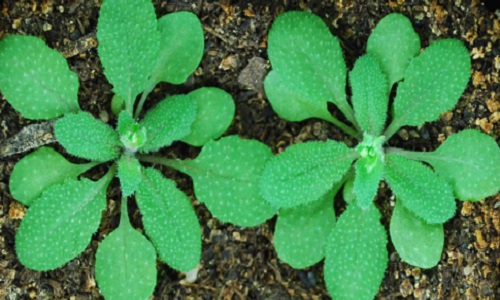Bioscience
Getting to the roots of microRNA
Proteins that have dual roles in the molecular processing of RNA could be manipulated to produce tougher plants.


Plants with deletions of HOS5, RS40 and RS41 (right) could be more resistant to harsh conditions compared to genetically unmodified plants (left).
© 2015 KAUST
Three plant proteins that contribute to RNA templates for protein synthesis are also involved in making RNA molecules that regulate gene expression, researchers from KAUST discovered in a recent study1.
The findings provide insight into fundamental cellular mechanisms in plants and animals and could offer a way to make plants more resistant to harsh conditions.
RNA is produced during the decoding of DNA, which acts as a template for RNA production during this process. There are several types of RNA, but the most well-understood is messenger RNA (mRNA), which itself acts as a template for the synthesis of proteins. The importance of microRNA (miRNA), another type of RNA, is now becoming clear.
MicroRNAs regulate the expression of protein-encoding genes, but the mechanisms behind their synthesis are poorly understood. Liming Xiong, Associate Professor of Bioscience, and colleagues from KAUST’s Division of Biological and Environmental Science and Engineering set out to gain some insight into miRNA by studying plants.
“The miRNA biogenesis pathways in plants and animals share many common themes, but it is relatively easy to obtain plant mutants that are defective in the process,” explained Xiong.
Previous studies indicated that proteins needed to process messenger RNA are also involved in miRNA synthesis. Xiong’s group had already shown that the proteins HOS5, RS40 and RS41 take part in the splicing of messenger RNA, in which RNA is edited. Their next step was to use genetically modified plants to see whether these splicing factors are also implicated in miRNA synthesis.
The researchers found that genetic deletion of HOS5 altered the expression of 27 percent of all miRNA molecules, and deletion of RS40 and RS41 altered expression of 17 percent. Studying the molecular interactions of the three splicing factors revealed that they bond to three proteins that are established components of the miRNA biogenesis system.
“We found that certain messenger RNA splicing factors moonlight in miRNA biogenesis in a way that does not require their primary splicing function,” Xiong noted. “This could explain the many contradictory findings regarding the role of splicing factors in small RNA biogenesis.”
The team also found that deleting HOS5, RS40 and RS41 amplified the response of the plant roots to the hormone auxin, causing their roots to gravitate more than unmodified plants.
“This promotes roots to grow straight down and could increase the plant’s drought stress tolerance, as water is more available in deeper soil,” explained Xiong. “Therefore, it might be possible to regulate the expression of miRNA to improve plant drought tolerance.”
References
- Chen, T., Cui, P. & Xiong, L. The RNA-binding protein HOS5 and serine/arginine-rich proteins RS40 and RS41 participate in miRNA biogenesis in Arabidopsis. Nucleic Acids Research 43, 8283-8298 (2015).| article
You might also like

Bioengineering
High value harvests from designer algae

Bioscience
Digging into the world of plant-growth-promoting microbes

Bioengineering
Stray DNA fragments challenge CRISPR precision

Bioscience
Unique microbiome discovered in mountain streams

Bioscience
How a multitasking protein keeps the body’s clock in sync

Bioscience
The theory of everything that wasn’t

Bioscience
Mangrove microbes to munch on plastic

Bioscience



